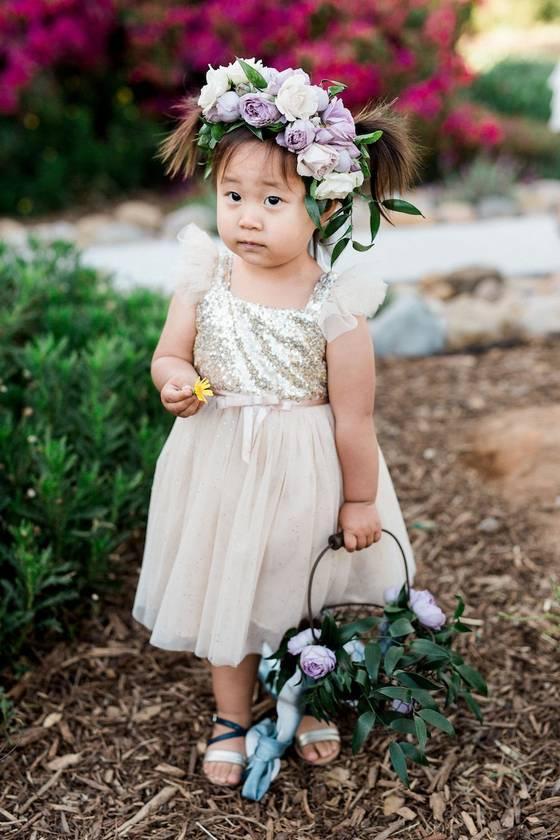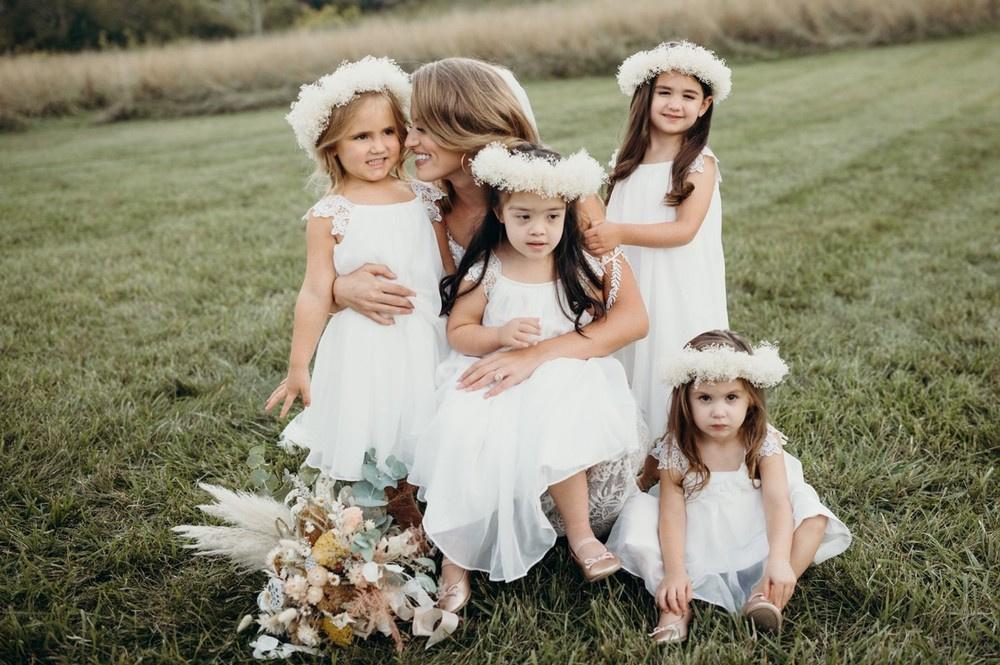Everything You Need to Know About Flower Girls
Your flower girl is bound to steal the show at your wedding—here's everything to consider when asking her to be a part of your special day.

If you've ever attended a wedding, you know that the flower girl's entrance is always an adorable moment—even when it doesn't go perfectly. Whether it's walking down the aisle, dancing with bridesmaids at the reception, or cracking silly faces in wedding party portraits, flower girls bring plenty of spunk and cuteness to the day, and if you're planning to have one for your wedding, there are several details you'll want to consider. This guide will help you choose your flower girl, understand her role, and get you up to speed on flower girl etiquette (such as who pays for the dress).
Keep reading for all the important flower girl basics and duties.
Choose a flower girl who falls in the right age group.
Traditionally, a flower girl should be between the ages of three and eight years old, with a little wiggle room for slightly younger or older children. This ensures that she is mature enough to handle the responsibility of walking down the aisle while still being young enough to differentiate from a bridesmaid. Two-year-olds and infants are more likely to need a parent to escort (or carry) them down the aisle, and younger children might feel especially overwhelmed in the moment. If your flower girl is 10 or older, consider making her a junior bridesmaid instead—you can even involve her in some of your planning process, such as shopping for dresses or getting your nails done together.
Think of siblings, friends, or relatives who are parents.
Choosing your flower girl might be an easy decision—maybe you have a daughter of your own, or maybe one of your siblings, best friends, or close relatives has a young daughter you’re close with. In any case, your flower girl should be someone who’s part of your close family or friend group. If you barely know her or only see her once a year, it may seem like a random choice.
Don’t be afraid to get creative if there’s not an immediate flower girl choice on the horizon. Are there young boys in your family who could handle the responsibility instead? (Yes, you can totally have a flower boy if you want!) Or maybe your cousin’s pre-teen daughter would be willing to fill the role of flower girl-meets-junior bridesmaid. If all else fails, you can ask one or two of your adult attendants to toss flowers as they walk down the aisle—it’s a funny and unexpected way to personalize your ceremony.

Remember that her parents will also be involved.
When you’re choosing your flower girl, remember that her parent(s) will also need to be involved, especially if she’s very young. They’ll be doing most—if not all—of the work leading up to your wedding, from purchasing her outfit to helping her understand exactly what she’s supposed to do on the big day. They’ll also be responsible for attending many of your pre-wedding events, such as your bridal shower and rehearsal dinner, in addition to arriving early on the day of the wedding. It’s important that you’re on good terms with your flower girl’s parents and that they’re comfortable dedicating time and money to their child’s involvement. If you’re unsure, just ask them!
Ask your flower girl in a thoughtful way.
Once your flower girl’s parents have given you the green light, it’s time to think about how you’ll ask her to be part of your special day. Many couples choose to surprise their flower girl with a thoughtful, age-appropriate gift, like a stuffed animal, keepsake jewelry, or a music box.
Save meaningful roles for other littles.
While it’s definitely an option to have more than one flower girl, you can also designate special roles for kids who won’t be part of your actual ceremony. Consider giving them other duties, such as walking behind the flower girl and/or ring bearer with a banner, passing out programs to guests, or blowing bubbles during your wedding recessional.

Flower girl FAQs
- What is the role of a flower girl?
The flower girl traditionally follows the last bridesmaid or maid of honor in the wedding processional, right before the bride makes her entrance. She often scatters flower petals, herbs, or confetti as she walks—centuries ago, this symbolized good fertility for the bride. Once your flower girl reaches the altar, she can either stand with the rest of the wedding party or return to sit with her parents. During the reception, your flower girl can be announced with the rest of the wedding party entrances if she’s comfortable enough (if not, you can enlist a bridesmaid or parent to walk in with her).
- How old are flower girls?
The best age for flower girls is between three and eight years old. Depending on your situation, she can be slightly younger or older. If she’s between the ages of 10 and 16, you can designate her as a junior bridesmaid instead.
- What does the flower girl wear?
Traditionally, the flower girl wears a white dress with similar features to the bride's attire, such as lace, beading, or floral appliqués. Alternatively, she can match the bridesmaids by adding a colored sash or wearing a similar dress style. Tutus, pink dresses, and sequins are also popular (and adorable) options. Flower girl dresses can be purchased online or at many bridal and formalwear boutiques. Comfortable shoes, like sandals and ballet flats, are best for younger flower girls, while older flower girls often wear shoes with low heels. Stockings, hair accessories, and jewelry are optional depending on your wedding style.
- Who pays for the flower girl dress?
The flower girl’s parents are traditionally responsible for purchasing her dress. If you’re able and willing to pay as the couple, it’s a nice gesture.
- How much should a flower girl dress cost?
The cost of your flower girl dress will vary depending on where it’s purchased, the style of the dress, and the age/dress size of the flower girl. On average, you can expect to spend between $50 and $150 on a flower girl dress, but you’ll also need to consider the cost of alterations, shoes, stockings, and other accessories.
- Do flower girls wear veils?
Flower girls often wear veils, headbands, flower crowns, or tiaras that resemble the bride’s accessories.
- How many flower girls can you have?
There’s no rule stating how many flower girls you can have, but we recommend sticking to three or four flower girls at the most to prevent your wedding party from becoming too big.
- Does the flower girl get ready with the bride?
Depending on her age, the flower girl often gets ready with the bride. If you would like her to have her hair professionally styled, you should offer to cover the cost, especially if you are doing so for the rest of your wedding party. If your flower girl gets ready on her own, she should arrive to your venue early enough to take group portraits before the ceremony.
- Does the flower girl have to throw petals?
While the flower girl traditionally throws petals, some wedding venues do not allow real petals or confetti to be tossed along the aisle. If your flower girl isn’t throwing petals, she can blow bubbles, carry a small bouquet, basket, pinwheel, or a sign instead.









